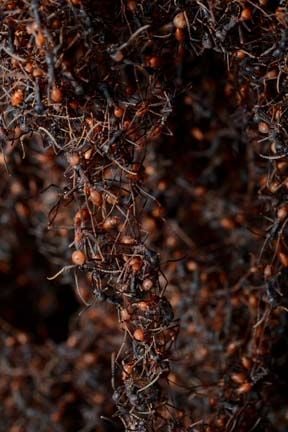Biological designs could guide computer systems
Source: Diana Campbell
 Martin Cenek’s research could be the start of a good joke: “A physicist, a biologist, an engineer and a computer scientist walk into a bar.”
Martin Cenek’s research could be the start of a good joke: “A physicist, a biologist, an engineer and a computer scientist walk into a bar.”
It’s likely one of the best ways to explain his work, since it’s still in the abstract phase. Cenek sees a network of tiny computers that speak to each other much like neurons in the brain do. But to get there, Cenek, a computer scientist, has had to look for help in biology, engineering and physics.
Cenek is working on solving a growing problem in computing — as circuits get smaller, they are losing speed and power. So he’s taking a step outside of standard computing practice.
“Let’s look at biology, because that works,” said Cenek, an assistant professor of computer science at the University of Alaska Anchorage.
Cenek was the kickoff speaker for the Geophysical Institute’s 2016 Science for Alaska Lecture Series, now in its 24th year. About 130 people attended the event held at the Westmark Fairbanks Hotel in mid-January. He was the pick from the Alaska Experimental Program to Stimulate Competitive Research, a sponsor of the series.
The complex talk featured brains, fire ants, slime mold and computer theories.
Finding new solutions to ease human labor has been the basis for the evolution of machines, Cenek explained during his talk. The Industrial Revolution, from 1760 to about 1840, brought machines to manufacturing. By the end of that period came the first shift in thinking about machines. Workers needed a way to control the massive moving parts of equipment to improve efficiency, Cenek said.
The code-breaking machines of the World War II era were the second shift in thinking; this time information extraction was the key.
Computers once took up whole buildings. Now they can be worn as fashion accessories as science has found ways to place more transistors into circuits.
The paradigm is shifting again, Cenek said, and it’s time to rethink computer processes. Nature has answers, he suggested.
Look at fire ants, he said. A flood can wipe out an ant colony, yet the worker ants band their bodies together to make a bridge. The colony’s queen and food supply can be carried to safety and a new home.
“If one ant goes berserko and falls away, the rest of the ants don’t fall apart,” he said. They keep going, he added. Each ant is autonomous, but it communicates with its neighbors by pheromones.
That scenario brought Cenek to look at the neurons of the human brain. They communicate electrically and can do a multitude of tasks independently, with the overall purpose of keeping a body functioning.
“The brain does not turn on and off in synchronicity,” Cenek said. “But it still gets the job done.”
Under a grant from the Department of Homeland Security, Cenek is looking at the possibility of using a network of computers, each about the size of a dollar postage stamp, to monitor the U.S.’s northern borders. He sees himself tossing out a few thousand over a section of land, letting them fall into a pattern. Each computer would act like the ant, or a neuron, and only interact with neighboring computers.
If something happens — say a moose walks by — the computer would alert the network. Some of the computers would be equipped to move the information out of the network to whoever or whatever is monitoring it, Cenek said.
He’s a about a year away from doing a test. There are environmental concerns and more engineering to be done. And more looking into other sciences for guidance.
“I’m not a biologist, neurophysicist, environmental scientist or engineer.” Cenek said. “I’m a computer scientist. I feel the solutions for humanity have to be inclusive.”
The Geophysical Institute’s Science for Alaska Lecture series is in its 24th year, with the Triplehorn family and the Alaska EPSCoR as sponsors.
| }
|